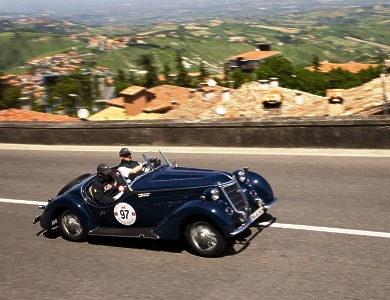
Automotive Intelligence - the web for automotive professionals and car enthusiasts
May 16, 2007
This Week:
-
Tom LaSorda comments on the Sale of Chrysler Group to Cerberus Capital Management, L.P.
-
DaimlerChrysler celebrates groundbreaking of its new Mercedes-Benz plant in India
-
General Motors To Invest $63 Million In Its Saginaw Metal Casting Operations
-
Tartaglione to become the head of management at Volkswagen Group Italia
-
Rainer Genes named new head of Production Planning Mercedes-Benz Passenger Cars
© 1998 - 2007 Copyright
&
Disclaimer
Automotive Intelligence,
www.autointell.com
All Rights Reserved .
For questions please contact
editor@autointell.net
|
Thomas Gottschalk and Audi at the Mille Miglia Three Wanderer and two DKW models on the grid in Brescia F 91 lines up for the first time since its class victory in 1954
Celebrities from the world of film and
television are crewing the Audi Tradition models taking part in
the 25th Mille Miglia in Italy (17 to 19 May). During the
world’s fastest classic car rally, TV show host Thomas
Gottschalk will be sitting alongside Audi Board Member for Sales
Ralph Weyler in a Wanderer W 25 K. In another model of the same
type, actor Thomas Heinze and Volkswagen’s Head of
Communications Stephan Grühsem will make an assault on the
race’s 1,000 miles. Finally, Karl-Friedrich Scheufele, founder
and managing director of Chopard, Mille Miglia’s chief sponsor,
together with Le Mans legend Jacky Ickx, will be driving the
third Wanderer, which is taking part in the rally for the first
time. Audi Tradition will have a total of five cars on the grid.
Making its first present-day appearance is the DKW Sonderklasse
F 91, which wrote its own history at the Mille Miglia. |
|
|
|
In 1954, Heinz Meier from Düsseldorf drove this car to victory in the touring car class up to 1300 cc at the classic event among European endurance races. Back then, the three-cylinder model – with an output of 34 bhp and a capacity of 900 cc – had an average speed of 104.95 km/h. In the same year, this DKW went on to win the “European Championship for Series Touring Cars”. The DKW Monza will be making its second appearance at the now legendary Mille Miglia. T |
his sporty DKW came onto the market in 1956 and set five world records in the class up to 1,100 cc in the very same year. Three Wanderer W 25 K models will round off the contingent of cars entered by Audi Tradition. These stunning roadsters dating from the 1930s had their baptism of fire at the last two Mille Miglia events.
The 1,000 miles of this classic race are routed from Brescia via Ferrara to Rome and from there directly back to the starting location in Northern Italy. The Mille Miglia has absolutely nothing to do with common perceptions of a classic car rally. Numbering 375, the starters, who can count themselves lucky for having been allowed to take part by the organiser, have just two days and a night-time stage of around four hours in which to cover 1,500 kilometres. And both man and machine are tested to the limits. The nights are short, the breaks are few and far between, the pace is high – and all this in historic cars for which luxury as we know it today is an alien concept.
The four rings of the Audi badge symbolise the brands Audi, DKW, Horch and Wanderer, which were later combined under the umbrella of Auto Union. Auto Union and NSU, which merged in 1969, made many significant contributions towards the development of the car. AUDI AG was formed from Audi NSU Auto Union AG in 1985. Together with the two traditional companies Auto Union GmbH and NSU GmbH, Audi Tradition conserves and presents the extensive and multi-facetted history of Audi. The Audi museum mobile at the Audi Forum Ingolstadt is open daily from Monday to Sunday, from 9 a.m. to 6 p.m.
All Photos: Audi
(May 11, 2007)
| .
Homepage News Companies Management Publications Events Guestbook Search . |
